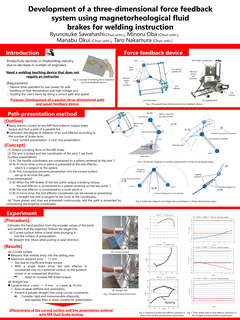Introduction
While welding has been automated in recent years, manual welding is still used in the shipbuilding industry. Due to the shortage of labor, there is a need for an efficient welding instruction device that does not require an instructor. The use of a motor as an actuator is considered, but since it is actively drive, there is a possibility that it will move in a manner unintended by the operator. In welding environments where high temperature and high voltage arcs are used, there is a risk of danger to the operator. Therefore, this study aims to realize a path presentation in three-dimensional space by using a device with a passive drive unit that uses MR brakes and a delta-type parallel link mechanism.
Design
Fig. 1 shows the developed device. Three MR brakes are place on the base plate at the fixed end of the device, and the arms are connected with one degree of freedom of rotation. Each arm is connected to the end-effector by a four-link parallel link. Due to the structure of the parallel link, the end-effector moves parallel to the base plate.
Experiment
The purpose of this experiment is to verify whether the path presentation method that locks with the braking force of the MR brake can present curved surfaces. The experimental motion was a circular trajectory in each of the three axial planes. The experimental results on the horizontal plane are shown in Fig. 2. It was confirmed that MR brake can provide force-feedback to inhibit intrusion into the set area. The maximum distance error was approximately 11 mm. The main cause of the error is considered to be slippage due to insufficient brake torque.

Fig. 1 Proposed force feedback device.

Fig. 2 Setup surface and trajectory in a curved surface presentation experiment.


Comment submit